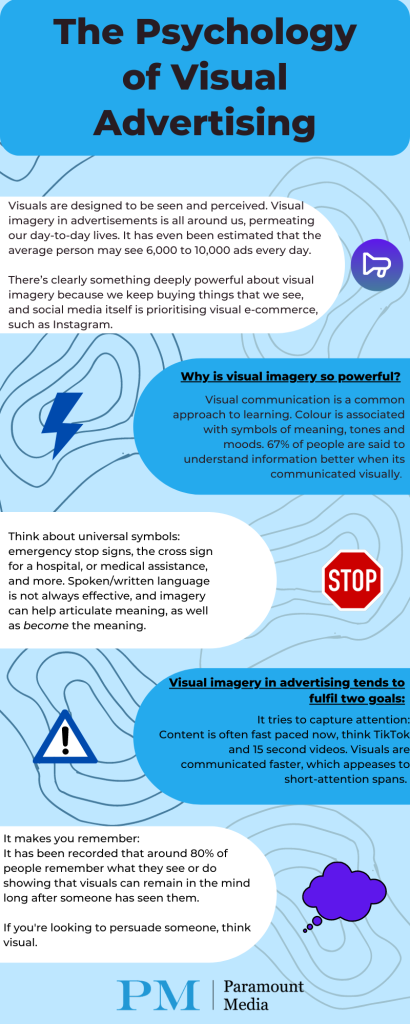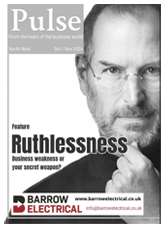

The Psychology of Visual Advertising
Visuals are designed to be seen and perceived. Visual imagery in advertisements is all around us, all the time, permeating our day-to-day lives. It has even been estimated that the average person may see 6,000 to 10,000 ads every day.
Think about all the content that is promoted on social media platforms, think about banner ads, paid promotions on YouTube videos, reminders of products and companies galore.
There’s clearly something deeply powerful about visual imagery because we keep buying things, and apps such as Instagram are being updated to not just support, but prioritise e-commerce, even to the detriment of the personal content that made it so popular when it began.
So why is visual imagery so powerful?
Visual communication is a common approach to learning, and a captivating way to articulate information. We are accustomed to seeing imagery as having meaning, colours symbolising various moods and tones, and text often being represented through interesting and eye-catching fonts.
67% of people understand information better when it is communicated visually, according to TechSmith. A lot of people comprehend complicated topics through imagery playing through their head, visual references that pop up and conclude in the full picture. These may be unique to the individual’s perspective, but nevertheless, imagery helps form this.
Visual communication assumes an audience, and its very nature is about interaction and perception. In many ways, the visual is more powerful alongside words and numbers than they are alone – there’s a reason why some symbols are repeatedly used, such as emergency stop signs, the cross sign for a hospital or medical assistance, and more. These visual symbols are universal, so that spoken or written language is not always required to communicate.
Of course, you cannot make generalisations, not everybody is predisposed to preferring visual imagery and communication, but for many people for who do prefer visuals, making use of this predisposition is smart, and it works.
How is visual imagery used in advertising?
There’s a reason visual content is used on website and blogs by 49% of marketers. Because visual communication is so commonly used as a method of articulation, it has an undeniable relationship to psychology, and motivates consumers to find out about a business, and even purchase products they never knew they needed.
Visual imagery in advertising tends to fulfil two goals:
Capturing attention.
The content we consume has changed, and attention spans have shortened. This has largely been pinned down to the increased usage of mobile phones and social media applications, think TikTok and its 15 second videos. Visual communication can take less time to process and understand and is used often when information needs to get across fast. This is true of tutorial videos, entertaining infographics, product photography, and more.
Colour is often used to do this. Colours have universal meaning (though there may be variations depending on culture), such as red: emergency, love, anger, or blue: loyalty, intuition, and power. Colour has an almost instant connection to some meaning or symbolism, communicating ideas quickly.
Even featuring a celebrity can fulfil this goal – as this endorsement immediately catches the eye of the viewer and improves trust in the brand. Think about what a person in an advertisement does: often, they attempt to make eye contact with the viewer through talking to the camera. It can be hard to break eye contact – a visual tool to capture attention.
Making the viewer remember.
Are you more likely to remember a provocative image, or a sentence describing something? A mix of both is likely to be quite effective. Imagery that is placed alongside text persuades the viewer to imagine, and if it is significant enough, they may just remember it.
It has been recorded that around 80% of people remember what they see or do showing that visuals can remain in the mind long after someone has seen them. If you are attempting to persuade someone to trust your brand or purchase your services, think visual.
Visual communication is not going away any time soon. Videos, infographics, posters, photography and much, much more, stick in the minds eye and persuades most of us to like, and sometimes, even to buy. This undeniable relationship to human psychology is what makes visuals so important.
Check out our B2B Magazine here, to see how we visually advertise businesses from all over the UK.


